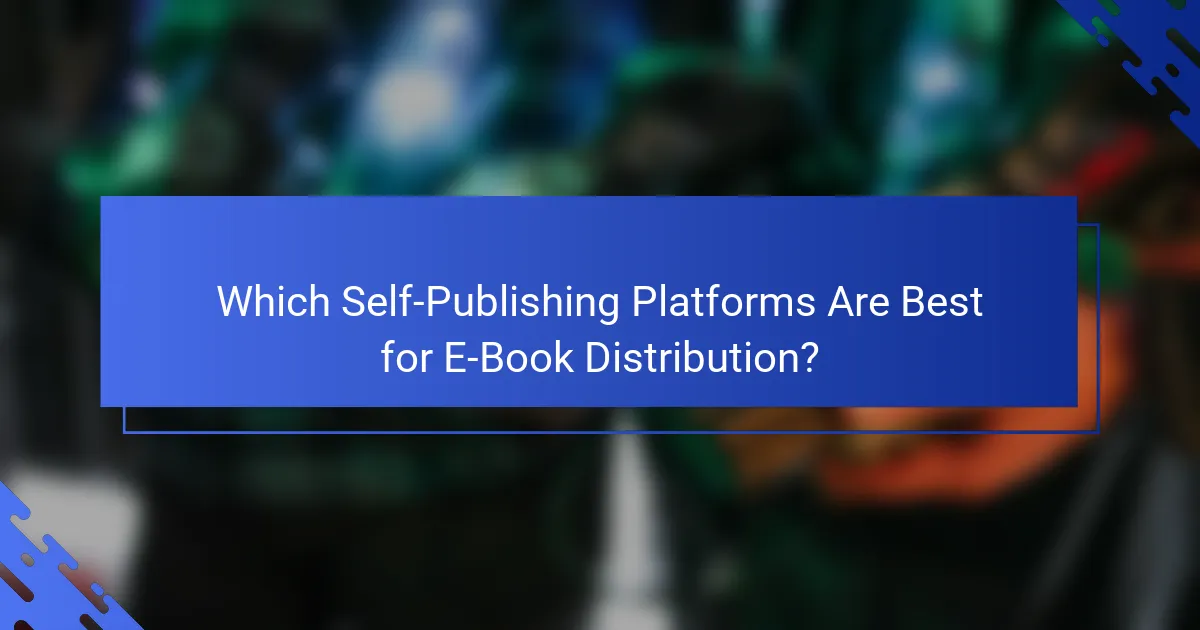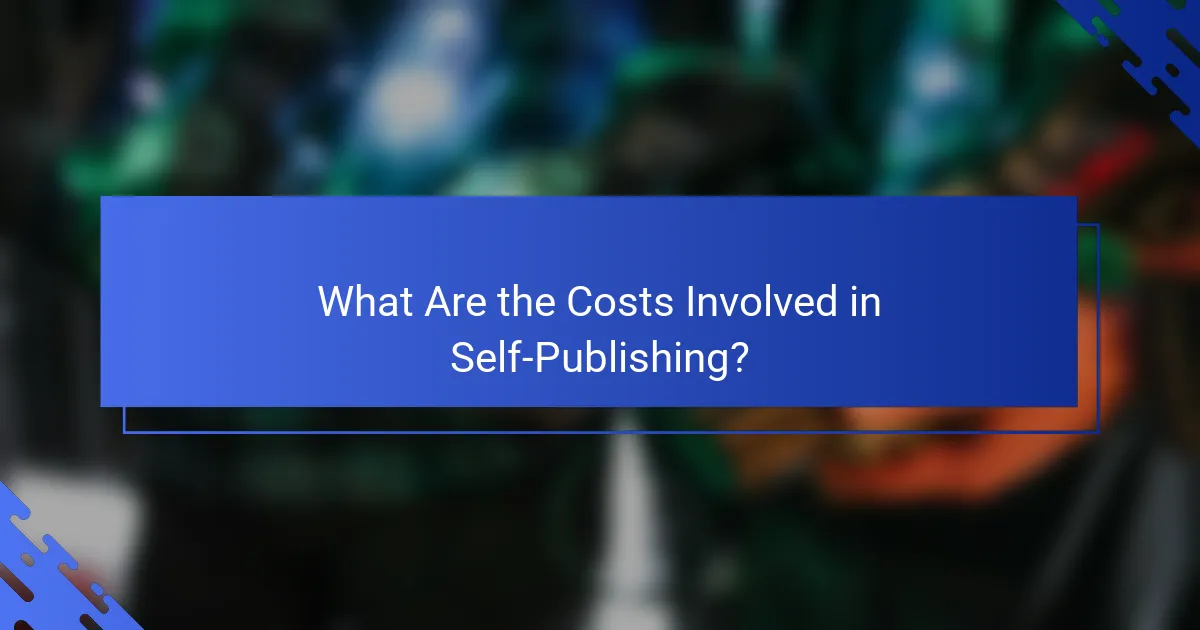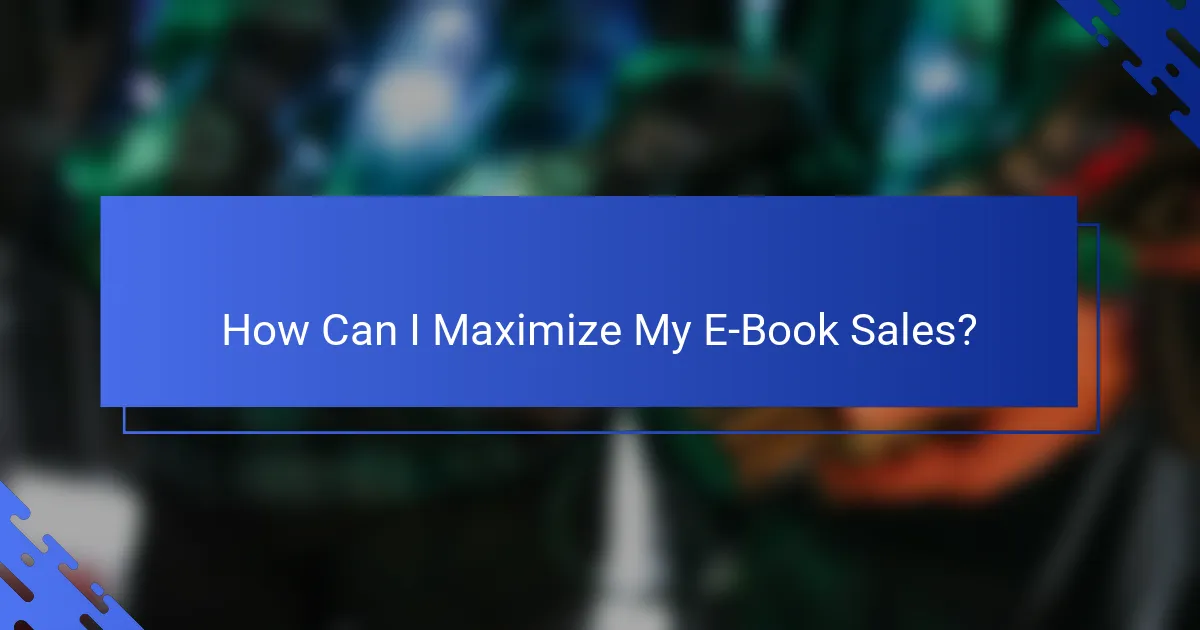Self-publishing platforms provide authors with various options for e-book distribution, each tailored to meet different needs and preferences. By considering factors such as target audience, distribution reach, and royalty rates, authors can select the platform that best aligns with their publishing goals. Understanding the unique features of each option is essential for maximizing the impact of your e-book in the market.

Which Self-Publishing Platforms Are Best for E-Book Distribution?
Several self-publishing platforms excel in e-book distribution, each offering unique features and benefits. The best choice depends on your target audience, desired reach, and specific publishing needs.
Amazon Kindle Direct Publishing
Amazon Kindle Direct Publishing (KDP) is one of the most popular platforms for self-publishing e-books. It provides authors with access to a vast audience through Amazon’s marketplace, allowing for global distribution.
KDP offers competitive royalty rates, typically around 70% for e-books priced between $2.99 and $9.99. Authors can easily upload their manuscripts, set pricing, and manage their titles through an intuitive dashboard.
However, exclusivity is a consideration; enrolling in KDP Select requires authors to sell exclusively on Amazon for a period, which may limit broader distribution options.
Smashwords
Smashwords is a versatile self-publishing platform that distributes e-books to a wide range of retailers, including Barnes & Noble, Apple Books, and Kobo. It allows authors to reach multiple markets without needing to upload their books to each retailer individually.
Authors can set their own prices and earn royalties of up to 80% depending on the retailer. Smashwords also provides helpful formatting guides to ensure e-books meet industry standards.
One downside is that the platform may have a steeper learning curve for formatting and uploading compared to others, but the extensive distribution network can be worth the effort.
Kobo Writing Life
Kobo Writing Life is a user-friendly platform that allows authors to publish e-books and reach readers in over 190 countries. Kobo is particularly popular in Canada and Europe, making it a great choice for authors targeting those markets.
With Kobo, authors can set their own prices and receive royalties of up to 70%. The platform also offers promotional tools to help boost visibility and sales.
However, Kobo’s market share in the U.S. is smaller compared to Amazon, so authors may want to consider their target audience when choosing this platform.
Draft2Digital
Draft2Digital simplifies the self-publishing process by distributing e-books to multiple retailers, including Apple Books, Barnes & Noble, and Kobo. It offers a straightforward upload process and automatic formatting services, making it accessible for authors.
Authors earn royalties of around 60-70% depending on the retailer, and Draft2Digital does not charge upfront fees, taking a small percentage from sales instead.
One key advantage is their responsive customer support, which can assist authors with any issues that arise during the publishing process.
Apple Books
Apple Books is a significant platform for e-book distribution, particularly for authors targeting Apple users. It allows authors to publish directly to the Apple ecosystem, reaching millions of potential readers.
Authors can set their own prices and typically earn around 70% royalties on sales. The platform also offers promotional opportunities through Apple’s marketing channels.
However, publishing on Apple Books requires a Mac or PC, and authors must adhere to specific formatting guidelines, which can be a barrier for some. It’s essential to ensure your e-book meets these standards for successful publication.

What Are the Key Features of Each Platform?
Each self-publishing platform offers distinct features that cater to different author needs, including distribution reach, royalty rates, user interface, and formatting requirements. Understanding these key aspects can help authors choose the right platform for their e-book distribution.
Distribution Reach
Distribution reach refers to the extent of a platform’s network in delivering e-books to various retailers and libraries. Some platforms, like Amazon Kindle Direct Publishing, have extensive reach, allowing authors to access a global audience, while others may focus on specific regions or niche markets.
When selecting a platform, consider where you want your e-book to be available. Platforms like Smashwords and Draft2Digital distribute to multiple retailers, including Apple Books and Barnes & Noble, enhancing visibility across different markets.
Royalty Rates
Royalty rates determine how much authors earn from each sale. Most platforms offer royalty rates ranging from 35% to 70%, depending on factors like pricing and distribution channels. For instance, Amazon typically offers 70% royalties for e-books priced between $2.99 and $9.99.
It’s essential to review the royalty structures of each platform. Some may have additional fees or conditions that affect overall earnings, so understanding these details can significantly impact your revenue.
User Interface
The user interface of a self-publishing platform can greatly influence the ease of use for authors. A straightforward, intuitive interface can simplify the publishing process, while a complex one may lead to frustration. Platforms like KDP are known for their user-friendly design, making it easy for authors to upload and manage their e-books.
Before committing to a platform, explore its interface through tutorials or demos. This can help you gauge whether it aligns with your technical comfort level and publishing needs.
Formatting Requirements
Formatting requirements dictate how your e-book should be structured before submission. Different platforms have specific guidelines regarding file types, layout, and design elements. For example, Kindle Direct Publishing accepts MOBI and EPUB formats, while Smashwords has its own style guide for formatting.
To avoid rejection or delays, familiarize yourself with each platform’s formatting standards. Consider using formatting tools or hiring professionals if you’re unsure about meeting these requirements, as proper formatting is crucial for a polished final product.

How Do I Choose the Right Platform for My E-Book?
Choosing the right platform for your e-book involves understanding your target audience, pricing strategies, and available marketing tools. Each platform has unique features that cater to different needs, so evaluating these aspects will help you make an informed decision.
Target Audience Considerations
Identifying your target audience is crucial when selecting an e-book distribution platform. Consider where your readers are most likely to purchase books—whether through Amazon, Apple Books, or niche platforms like Smashwords. Each platform attracts different demographics, so align your choice with your audience’s preferences.
Additionally, think about the genres you are writing in. Some platforms may have a stronger presence in specific categories, such as romance or self-help, which can influence your book’s visibility and sales potential.
Pricing Strategies
Pricing your e-book effectively can significantly impact its success. Many platforms allow you to set your own prices, but they may take a percentage of your sales, which can vary widely. For example, Amazon typically takes around 30% to 65% depending on the price range you choose.
Consider offering promotional pricing or discounts to attract initial readers. Some platforms also enable you to run limited-time offers, which can create urgency and boost sales during launch periods.
Marketing Tools Available
Effective marketing tools can enhance your e-book’s reach and sales. Look for platforms that provide built-in promotional features, such as email marketing, social media integration, or advertising options. For instance, Amazon offers promotional tools like Kindle Countdown Deals and Free Book Promotions.
Additionally, consider platforms that allow you to build an author page or provide analytics to track your sales and reader engagement. These insights can help you refine your marketing strategies over time.

What Are the Costs Involved in Self-Publishing?
Self-publishing involves various costs that can significantly impact your budget. Key expenses include platform fees, editing and design costs, and marketing expenses, each of which can vary widely based on your choices and goals.
Platform Fees
Platform fees are the charges imposed by e-book distribution services. These can range from a percentage of your sales (typically between 15% to 30%) to flat fees for listing your book. Some popular platforms, like Amazon Kindle Direct Publishing, do not charge upfront fees but take a cut from each sale.
When choosing a platform, consider both the fee structure and the reach of the service. For example, while a lower percentage might seem appealing, a platform with a larger audience could yield higher overall earnings.
Editing and Design Costs
Editing and design are crucial for producing a professional-quality e-book. Editing costs can vary, with developmental editing ranging from a few hundred to several thousand dollars, depending on the manuscript’s length and complexity. Cover design can also cost between $100 to $500 or more, depending on the designer’s experience.
Investing in quality editing and design can significantly enhance your book’s appeal and credibility, potentially leading to better sales. Consider seeking quotes from multiple freelancers or agencies to find a balance between quality and cost.
Marketing Expenses
Marketing expenses can vary greatly based on your strategy. Basic marketing efforts, such as social media promotion, can be done at little to no cost, while more extensive campaigns, including paid ads, can range from a few hundred to several thousand dollars. It’s essential to allocate a budget for marketing to increase visibility and sales.
Consider using a mix of free and paid marketing strategies. For example, building an author website and engaging with readers on social media can be effective low-cost options, while targeted ads can help reach a broader audience.

How Can I Maximize My E-Book Sales?
To maximize your e-book sales, focus on effective marketing strategies, choosing the right platforms, and optimizing your pricing. Understanding your target audience and leveraging promotional tools can significantly enhance visibility and sales performance.
Choose the Right Self-Publishing Platform
Selecting the right self-publishing platform is crucial for reaching your audience. Popular options like Amazon Kindle Direct Publishing (KDP), Smashwords, and Draft2Digital offer various distribution channels and royalty structures. Consider factors such as ease of use, reach, and commission rates when making your choice.
For instance, KDP allows authors to publish e-books directly to Amazon, which dominates the e-book market. In contrast, Smashwords provides access to multiple retailers, including Apple Books and Barnes & Noble, which can broaden your audience.
Optimize Your Book Metadata
Optimizing your book’s metadata, including the title, description, and keywords, can significantly impact discoverability. Use relevant keywords that potential readers might search for, and craft a compelling book description that highlights your book’s unique selling points.
For example, if your e-book is a romance novel set in Paris, include keywords like “romantic Parisian adventure” in your metadata. This helps improve your book’s ranking in search results on platforms like Amazon.
Utilize Social Media and Marketing Strategies
Leveraging social media platforms can enhance your e-book sales by engaging with potential readers. Create a marketing plan that includes regular posts about your book, behind-the-scenes content, and interactions with your audience to build a community around your work.
Consider using targeted ads on platforms like Facebook or Instagram, where you can reach specific demographics. Additionally, offering limited-time discounts or free promotions can attract new readers and encourage reviews, which are vital for boosting sales.
Monitor Sales and Adjust Strategies
Regularly monitoring your sales data is essential for understanding what works and what doesn’t. Use analytics tools provided by your publishing platform to track performance metrics, such as sales trends and reader demographics.
Based on this data, be prepared to adjust your marketing strategies. If a particular promotional tactic is not yielding results, experiment with different approaches, such as changing your pricing or trying new advertising channels.
